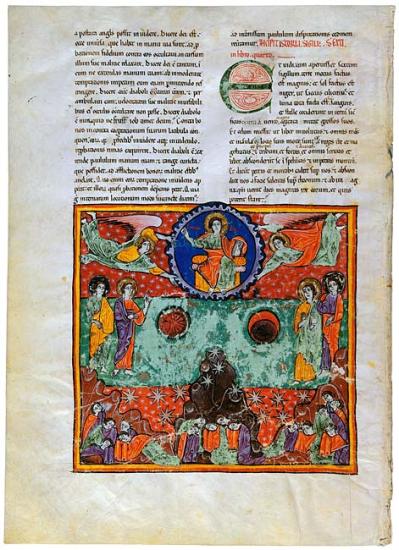
Opening Of The Sixth Seal: The Earthquake
Beatus of Liébana
Las Huelgas Apocalypse
Purchased by Pierpont Morgan, 1910
And when he had opened the sixth seal, I saw a great earthquake. And the sun became black, like a haircloth sack, and the entire moon became like blood. And the stars from heaven fell upon the earth, just as when a fig tree, shaken by a great wind, drops its immature figs. And heaven receded, like a scroll being rolled up. And every mountain, and the islands, were moved from their places. And the kings of the earth, and the rulers, and the military leaders, and the wealthy, and the strong, and everyone, servant and free, hid themselves in caves and among the rocks of the mountains. And they said to the mountains and the rocks: "Fall over us and hide us from the face of the One sitting upon the throne, and from the wrath of the Lamb. For the great day of their wrath has arrived. And who will be able to stand?" (Rev. 6:12–17)
At the top, two flying angels support the enthroned Christ in an aureole, while four elders are in attendance. The bottom part of the miniature follows the text.
The Apocalypse, or Book of Revelation, is not only the last Book of the New Testament, but its most difficult, puzzling, and terrifying. It provided challenges to medieval illustrators and was the source for a number of popular images, such as Christ in Majesty, the Adoration of the Lamb, and the Madonna of the Apocalypse and contributed to the widespread use of the Evangelists' symbols.
Selected images from Apocalypse Then: Medieval Illuminations from the Morgan, an exhibition held at the Morgan are presented here. The exhibition celebrates the completion of a facsimile of the Morgan's Las Huelgas Apocalypse—the latest dated (1220) and largest surviving manuscript of a Spanish tradition of illuminated commentaries on the Apocalypse by the monk Beatus of Liébana. The series of manuscripts constitutes Spain's most important contribution to medieval manuscript illumination.
The Las Huelgas Apocalypse contains three sections: the prefatory cycle, the Apocalypse, and the Book of Daniel.
In addition to forty-nine images from the Las Huelgas Apocalypse, six images from other manuscripts in the Morgan's collections, including the earliest Beatus painted by Maius and one by the Master of the Berry Apocalypse, are in this presentation.
